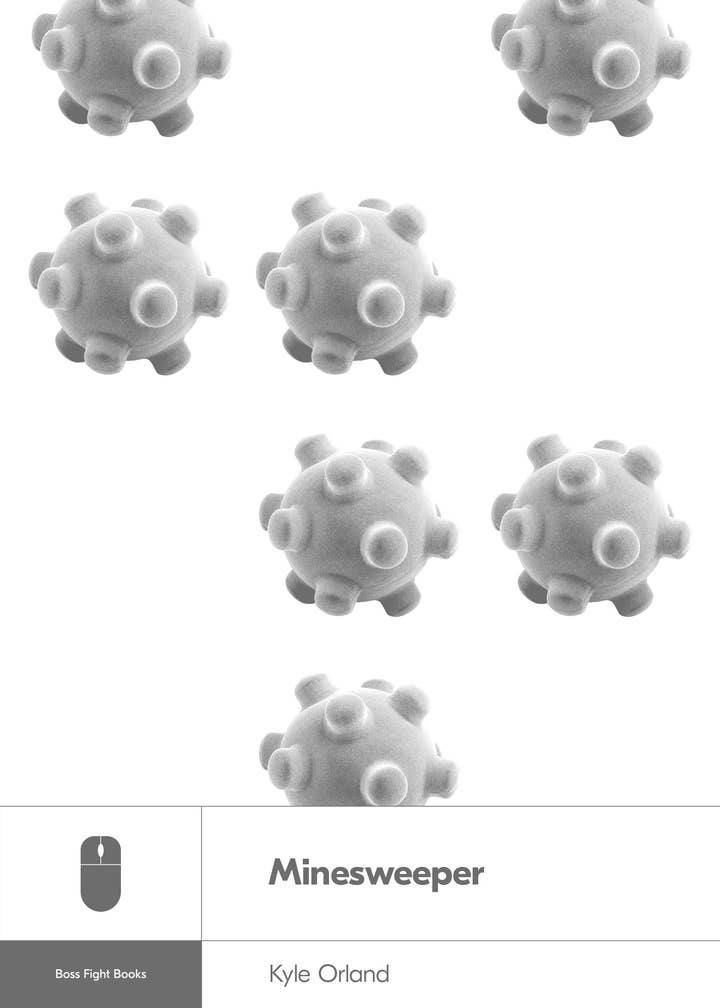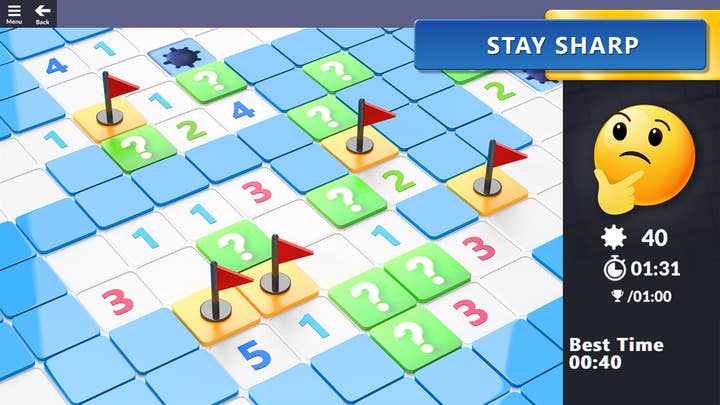How do you monetize Minesweeper?
Microsoft's attempts to get money from the Windows puzzler are detailed in this excerpt from Kyle Orland's upcoming Boss Fight Books release
(The following is an excerpt from Kyle Orland's upcoming book Minesweeper, an in-depth look at the history and evolution of the classic puzzle game that has been a mainstay of Microsoft's since it came pre-installed with every copy of Windows 3.1. It is one of four titles in Boss Fight Books' "Season 6," which has a Kickstarter campaign running until 10 p.m. Eastern on March 7.)
For most of its existence, Minesweeper had only existed as a free add-on for the Windows OS. Originally, the pre-installed freebie served as a marketing tool, helping to teach players how to use a mouse and differentiating Windows from competing operating systems.
By 2011, though, no one was taking Minesweeper into account when deciding which computer OS would best fit their needs. Minesweeper had become a vestigial appendix in Windows's increasingly bloated body, contributing next to nothing to Microsoft's bottom line.
Minesweeper had become a vestigial appendix in Windows's increasingly bloated body, contributing next to nothing to Microsoft's bottom line
The Windows 8 version of Minesweeper changes this in some serious ways. While you can still download and play the game for free, you now have to endure a number of ads to do so. The first one appears right on the main menu screen, a small square banner of the type you might see on the side of a web site. Similar banners appear next to each individual puzzle and even on the results screens after you finish a challenge.
As if that wasn't enough, a new game is occasionally interrupted by a 30-second video ad that runs before you can play. In Treasure Hunt, the Minesweeper Adventure Mode spin-off, these video ads are even integrated in the presentation as a major event.
"Every time […] you find the entrance to a hidden level with treasures, you need to see a video ad," [Arkadium Director of Game Design Alexander] Porechnov said. "Everyone likes to do this, they are happy to see this [ad]. We even introduce this video ad with a cinema theater, curtains, it's like you're watching a movie. Then you have the entrance to the hidden level and you have big satisfaction grabbing all of these treasures really quickly."
For those players who are somehow, inexplicably not "happy to see" an ad before they get to play a bonus level, there is an option to pay for an ad-free version of the game. But you can't simply make an upfront payment to remove ads forever. Instead, you need to sign up for a $9.99 annual "premium" subscription plan (or a $1.50 monthly subscription). That's not such a high price to ask for those who play regularly, even if it is a big bump up from the former price of "free with OS purchase."

Still, I have to wonder how many people are still getting billed for a version of Minesweeper they no longer even think about.
[Microsoft Casual Games Design Director Kevin] Lambert, for his part, insists that monetization was never the core design concern in Microsoft's Minesweeper revamp.
"It wasn't like, 'Number 1: How do we make money. Number 2: How do we make a good game?' It was more of a balance[…] We're always balancing the user experience with revenue opportunity."
That said, the need to drive more player engagement — and therefore more ad and subscription revenue — seems to be behind the new Minesweeper's other main gameplay innovation: Daily Challenges. If a standard game of Minesweeper is a game of chess, the Daily Challenges are a bit like those newspaper chess puzzles that ask you how to get to a checkmate in a set number of moves: micro-sized doses of Minesweeper with a small twist on the formula.
There are some interesting ideas to be found in the Daily Challenge puzzles. Detonation Mode is perhaps the most satisfying, asking players to tap the mines rather than the safe spaces. (This mode is also easier to play on touchscreen devices, since you don't need to use multiple taps to place flags). Treasure Hunt mode is more frustrating, asking players to intuit the single square on an Expert-sized board that's completely surrounded by mines.
Other Daily Challenge modes offer only small restrictions on normal gameplay. Taps mode removes the ability to place flags, requiring you to uncover a few blocks without that crutch, while Flags mode only allows you to mark a set number of mines on a board where some blocks have already been revealed.
As interesting as the Daily Challenge modes are, though, their implementation can't help but feel exploitative.
Completing these challenges rewards the player with virtual coins that fly into an onscreen account with a jangly animation. At the end of each month, those coins go toward in-game trophies of increasing rarity, an onscreen recognition of the time committed to the game. You can retry each Daily Challenge as many times as you want until the end of the month, which makes the true cost of failure nothing but more time spent playing.
It feels weird for Minesweeper to be leaning on an artificial, extrinsic motivation rather than the simple thrill of logical deduction and self-improvement...
This isn't quite as sleazy as some freemium mobile games, which would try to upsell you on some assistance items if a Daily Challenge turned out to be too difficult. Still, it feels weird for Minesweeper to be leaning on an artificial, extrinsic motivation rather than the simple thrill of logical deduction and self-improvement that drove millions of regular players for decades.
According to Lambert, though, the classic version of the game was no longer driving the daily engagement needed to take full advantage of an ad-based revenue model.
"When we looked at the motivations of the people that play these games, [I'd ask] 'Why are you playing Minesweeper on a day-to-day basis?'" he said. "And they say, 'I play it to train my brain, to keep my mind sharp.' Some people play it to relax, some people see how fast they can go, [or say,] 'I like to win,' [or,] 'It's just an escape—I like to take a break.' These are the kinds of things we're seeing in the motivation studies that we did."
What was missing from those motivation studies, Lambert said, was people saying, "I need to play Minesweeper and I need to play Solitaire. So how cool would it be if we could come up with something so compelling that when we ask them why they're playing, they'd say, 'Because I need to play Minesweeper today!'"
Of course, that decision probably seems "cooler" when it encourages the kind of regularized play that drives more regular ad views (and more income for Microsoft).
"Towards the end of the month… now you have people say, 'Okay I have to play Minesweeper today because I have to finish the month out [and get a trophy],'" Lambert said. "And you're like, 'Haha, you just said, 'I have to play Minesweeper today.'"
As intrusive as the new ads and design may seem relative to the classic Minesweeper experience, Lambert insists it could be much worse.
"The way that we present ads in our game absolutely leaves revenue on the table"Kevin Lambert
"A lot of [mobile games] are really aggressive, and they jam ads down your throat," he said. "A 30-second ad for a 15-second level? That doesn't seem like a very good value proposition. The way that we present ads in our game absolutely leaves revenue on the table. We could be making a lot more if we just cranked our dials up. The reason we don't is because of that balance. We're trying to balance that user experience."
"And it totally works," he continued. "If you look at our reviews and our retentions and our scores, it's very indicative that that balance has worked well for us[…] Some people did [complain] of course, 'The purity, you have upset the purity!' But by and large we are getting 4.5 to 5 star ratings on the experience, so I think it went pretty well."
The quest for monthly trophies, it turns out, helps drive a "need" for repeated Minesweeper play that some players find even more addictive than the original game.
Perhaps that's not surprising, given Minesweeper's freeware history and its original creators' utter indifference to making it a commercial product in the first place.
Still, it's… interesting to see Microsoft adding explicitly addictive design patterns to a game that has already claimed many an addict over the years.
Three decades ago, game makers largely used trial and error to stumble into game designs that kept players coming back for more. Today, the process has been professionalized with player motivation studies, ad monetization formulas, and other tools intended to maximize continuing revenue. Seeing these modern design touchstones infecting a classic freeware title like Minesweeper puts into stark relief the scale of the industry's evolution on this score.
